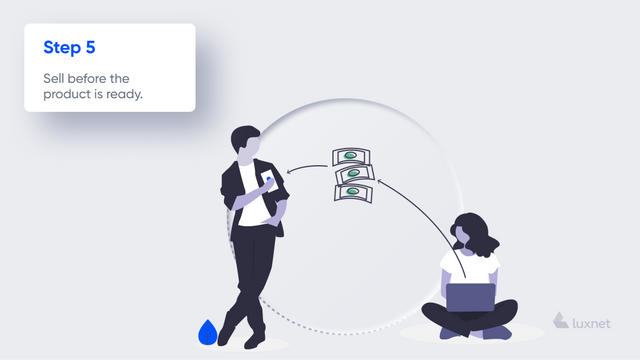It is notorious that the integration of technology into the life of the company is a great advantage that influences the achievement of success, an increase in profits and, what is more, customer satisfaction. Taking into consideration this sort of demand, many entrepreneurs have thought about setting up a tech company.
However, the IT industry is saturated with these projects nowadays. That’s why you should consider all the pros and cons before launching a startup in this area. Moreover, you should take a fresh look at the service market and offer something that potential competitors do not have. It is not always a unique product (although, such "newcomers" are pretty popular on the market), sometimes you can turn a customer into a regular one thanks to good service, team experts or speed and quality of tasks execution.
In this article, we will describe 9 steps to start a tech business, as well as the challenges that business owners usually face.

Step 1: Start from scratch - write down your ideas.
Take your time to think over the idea. Why do you need such a business? Why have you chosen a technology company? How do you plan to implement the strategy? You should outline the main points that must be considered.
Let's face the truth: often it is better not to set up a company than to do so. The risks are huge. The startup might not become profitable, may crash in the early stages or fail a little bit later.
Before starting a tech company, draw up a strategy and vision; decide who will be involved in this business and what will be the roles. Here you can also create the cognitive map we wrote about earlier: it helps to visualize goals, strategy and challenges.

Step 2: Think about market needs.
A market, narrow or global, is a flexible platform, a holistic ecosystem that is already working. There are companies that offer a quality product and there are satisfied customers. First of all, and it's logical, think about what market you're entering: internal or external, insourcing or outsourcing, etc. Secondly, assess what current demands on the market your solution can cover and what gaps it will fill. Actually, these actions are probably the most important at the beginning of the company.
CB Insights, for example, writes that most often startups fall apart due to the lack of established market needs - 42% of young companies in the world suffered from this; they were closed at the beginning. The second reason is the lack of money (29%) and the third is the badly formed team (23%).
Why does everything happen this way? Many startups, driven by the idea of starting a tech business, launch their projects without preliminary market analysis and thorough quality testing. So, how can you avoid such a situation?
Flood the market with:
- location - a particular city or country may not have the service you offer;
- new technology - when you propose a simple and good solution that has no equivalent on the market;
- adequate prices - if the service is too expensive, and you can (the keyword is you can, i.e., you are financially capable to) lower the price, make it more attractive and affordable to the customer;
- process simplification - when your decision makes everyday routine or work easier. For example, if earlier there was a need to change the handwritten text into a digital version, it was necessary to type the text manually. And then - oops! With the appearance of a scanner you can scan your text and digitize it - even turn the cursive handwriting into block letters.

Step 3: Outline your MVP.
What is the minimum viable product?
This is a product with minimal features that can be provided to customers to use. MVP is used to test ideas in the development of programs with minimal cost of resources. This product must have all the basic features to solve the problem you face. This is a kind of prototype that should demonstrate the interest of users, as well as the market need for this product. An example here can be a kerosene lamp. It was used before the electricity supply. It illuminated everything around; it could be moved from one place to another. After all, over some time the humanity switched to LED lamps. Unlike their predecessors, these lamps are powerful and energy-efficient.
In the case of successful startups, the kerosene lamp is the MVP and the LED lamp is the finished product.
Validate your MVP.
There is a high probability that your product will be profitable if it solves a certain problem and simplifies the life of the user, as mentioned above. These factors are incredibly important because they correspond in direct ratio to the future price of the product. Are customers willing to pay for the product? Will you find investors who want to finance? Will it be possible to "pay off" the costs invested in the project? How will the price affect company competitiveness?

Step 4: Build the best team.
Hiring employees is a difficult part of the job when it comes to the technical area. Education, experience and salaries for experts in their field play an important role. At the same time, startup employees need to be passionate about the idea and well aware of the risks and challenges of working in such a young company. Much attention should be paid to the HR manager, whose experience will allow you to assess the candidates rationally.
However, the startup must work in a sort of fundamental trio - marketing, accounting and operations. That is, not only developers are crucial ;)

Step 5: Sell before the product is ready.
Forbes recommends selling the product before you spend hundreds of hours on its developing, strategizing, and direct launching. Tell the target audience about your idea and suggest them to make a small investment into the service. For example, give them the opportunity to pre-order a product at a significant discount. Furthermore, ahead of time, you can look for investors who would contribute financially to the product. In the case of startups, most often they are angel investors, i.e., entrepreneurs who can also provide venture capital. In general, there are different strategies for the sale of goods in advance. These are pre-orders for your product, which bring in money for product development and allow you to assess effectively whether your service is interesting to potential users.

Step 6: Don't forget about marketing.
Advertising and product promotion is another important point. Essentially, marketing should keep pace with your MVP and start in the early stages of development. If you think that creating a product is the hardest thing in the process, actually, it isn’t. Everything just begins after the development stage. That’s great when you have the money for marketing. You can build a promotional strategy, organize different sales promotions, create, for example, a landing page of a business and advertise it at the beginning. But we also have more simple options: you can look for your audience ... on social media. Specialized groups on Facebook or a page on Instagram allow you to start a promotion, demonstrate the brand and evaluate the reaction of the audience.\

Step 7: Remember about your competitors.
Investigate the market and re-evaluate the company competitiveness. This plays a significant role in creating a technology startup. In fact, if the industry offers several options on the market and you have competitors, this also means that your product will be in demand. At the same time, you can also analyze your competitors; understand the challenges, problems and gaps. These things are necessary not to repeat other people's mistakes in the future.

Step 8: Make an adequate effort estimation of challenges and deal with them.
Apparently, a young company will face challenges. That is logical: you can even have a lot of them because the company is built from scratch. Nevertheless, you should know in advance how to avoid problems, how to evaluate failures well and use them only as the experience to develop in the future. Assess the risks, challenges, and look for internal solutions to overcome obstacles. Do these actions before you build your product and continue doing them all the time.

Step 9: Always have a plan.
It is the last, but no less important step. Make sure you have a strategy and several business plans to help you deal with the challenges and risks. You need to take care of all the subtle aspects and know what strategy you are following. Just in case, create a withdrawal plan: you should not be pessimistic, but it’s better to assess the chances of success rationally. Should anything happen, develop such a strategy of withdrawal from the company to feel more or less safe.
TL;DR
Starting a technology company is a hard and risky process. But if you combine it with creativity, desire and good ideas, such a business will bring profit and attract investors. Outline ideas from which you can later build a strategy, develop and test the MVP.
Do not neglect the recruitment of the team where people are not just professionals, but can also treat the startup with passion and inspiration. Business planning, marketing, planned and executed tasks are your best helpers.
